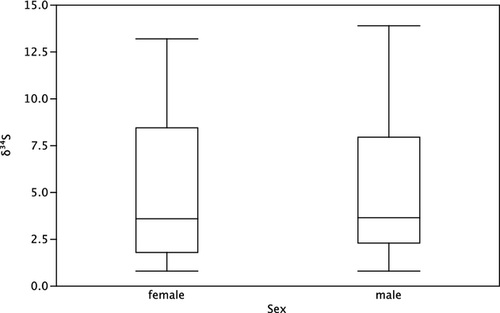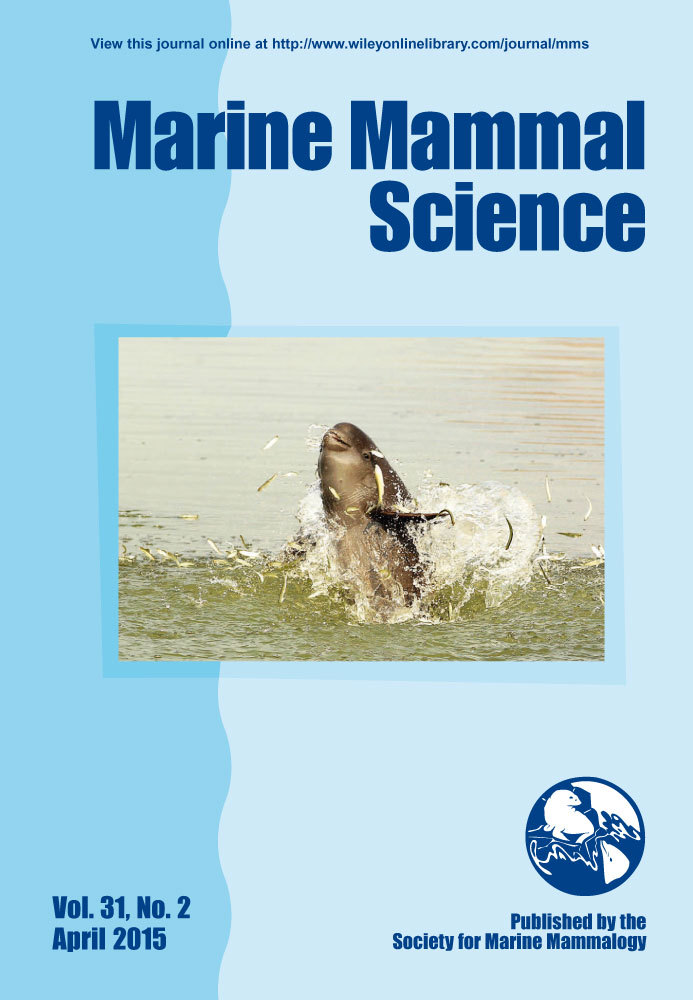Sulfur isotopes show importance of freshwater primary production for Florida manatees
The Florida manatee (Trichechus manatus latirostris) is an endangered marine mammal whose coastal habitat has been heavily altered by humans. Sources of mortality include environmental causes; however the heavy overlap between manatee estuarine habitat and human boating activity is certainly a large contributor to Florida manatee injury and mortality. Although manatees have the unusual tendency (among marine mammals) of imbibing freshwater, the degree of their reliance on freshwater or marine primary production for nutritional requirements needs to be better characterized. We hypothesize that if Florida manatees heavily use freshwater production, then the sulfur isotopes of their tissues may reflect its importance. Florida manatees often inhabit and feed upon seagrass beds, generally foraging at shallow depths, and are known to be generalist herbivores, often consuming floating vegetation and even terrestrial vascular plants (Marsh et al. 2012).
Sulfur isotopes have long been known to provide information regarding marine vs. freshwater primary production use. Marine sulfate is approximately 20‰, and marine fishes are typically 19‰ (Peterson et al. 1985); however, freshwater sources are usually much more depleted, depending on the sulfur source. Sulfur isotopes may be particularly good tracers because there is minimal diet-tissue discrimination, making source determination potentially less ambiguous than with carbon and nitrogen isotopes (Peterson et al. 1985). Sulfur isotopes have been used to identify marine protein utilized by freshwater ecosystems, after it has been transported by migrating salmon or herring (MacAvoy et al. 1998, 2000; Rinella et al. 2013). In those studies, an approximately 14‰ difference exists in δ34S between the marine and freshwater sulfur sources. Whereas sulfur isotopes associated with sulfate reduction in salt marshes tend to be extremely depleted (−10‰ to −25‰) (reviewed in Connolly et al. 2004), organic material in Florida's freshwater environments has values between 1‰ and 12‰ (Peterson et al. 1985, Peterson and Howarth 1987, Price and Casagrande 1991). An additional source of sulfur may be from seagrasses, which are consumed by manatees and tend to have variable δ34S values depending on the redox state of root-associated sediments and the availability of organic matter (Oakes and Connolly 2004, Holmer et al. 2009). Seagrass δ34S values between 12.7‰ and 17.6‰, approaching marine sulfate, have been reported for Redland Bay, Australia (Oakes and Connolly 2004); however, Florida Bay tropical seagrasses are 5.8‰ ± 0.4‰ (Halodule univervis) and 4.9‰ ± 0.5‰ (Cymodocea angustata), whereas temperate seagrass (Amphibolis antarctica) are 14.2‰ ± 0.6‰ (Belicka et al. 2012). Chanton and Lewis (2002) report that Florida (Apalachicola River) freshwater floodplain plants had δ34S values between −1‰ and 3.7‰, whereas freshwater submerged tape and widgeon grass (Ruppia maritima) had values of 11‰. Although the potential overlap of δ34S between seagrass and freshwater plants make it difficult to assess exactly what a manatee is consuming, they may reveal whether manatees utilize marine sulfate. δ34S values approaching 20‰ would clearly be from marine sulfate; lower values could result from consumption of either seagrass or freshwater vegetation (or both). Very negative values could indicate sediment sulfides incorporated while the manatees graze on seagrass roots, as they have been observed to do (Deutsch et al. 2003). Fry et al. (1982) reported sediment sulfides in Redfish Bay, Texas, to be −24‰ and both Koch et al. (2007) and Belicka et al. (2012) report porewater sulfides in Florida Bay to be between −6‰ and −10‰. Although stable isotopes cannot positively identify what is being consumed, they can identify what is not being consumed. This makes them a potential tool for differentiating the importance of offshore vs. freshwater or estuarine sulfur to Florida manatees.
The stable isotopes of carbon and nitrogen have been used in previous studies of trophic ecology of manatees (Walker and Macko 1999, MacFadden et al. 2004, Reich and Worthy 2006, Alves-Stanley et al. 2010, Ciotti et al. 2014). These isotopes indicate Florida manatees to be opportunistic herbivores with a possible preference for freshwater vegetation (Alves-Stanley et al. 2010). Reich and Worthy (2006) also used C and N isotopes to differentiate salt, brackish, and freshwater sources among 25 Florida manatees, and surmised between 50% and 100% marine primary production usage depending on location. As an additional tool for assessing the importance of freshwater vs. marine habitat to Florida manatees, we have compiled stranding locations and bone δ34S from manatees collected between 1970 and 2010. Although the variation of marine mammal bone/tooth δ18O or δ13C has been used as an indicator of freshwater or marine habitat usage for marine mammal paleoenvironments (Clementz and Koch 2001, MacFadden et al. 2004), and δ34S enrichment has been shown to be a tracer for modern marine organisms in coastal freshwater environments (MacAvoy et al. 1998, 2000; Barros et al. 2010; Rinella et al. 2013), this study is the first to use δ34S of manatee bone to investigate habitat.
Samples were obtained through the Florida Fish and Wildlife Conservation Commission (FFWCC) from the Manatee Rescue and Mortality Response Program (http://myfwc.com/research/manatee/rescue-mortality-response/), as authorized under a number of federal permits issued since 1974. Necropsies are performed on each carcass, and skeletal material is stored at various museums and other locations. Samples of bone from Florida manatees and copies of necropsy data sheets that included latitude and longitude of the individual animals were obtained from this program. The type of bone sampled and the latitude and longitude of the stranding location are in Table S1. Prior to isotope analysis, the bone fragments were ground using a Dremel tool and between 20 and 25 mg were packaged into tin capsules for isotope ratio analysis. δ34S was measured using a SerCon elemental analyzer and custom cryofocusing system interfaced to a SerCon 20-22 IRMS (Sercon Ltd., Cheshire, U.K.).
Most manatees were recovered in coastal areas, however a few were found in waterways well inland or offshore, based on the stranding information (Fig. 1). The carcasses could have drifted for days prior to being identified and necropsied, however the bone sulfur isotopes, which reflect integrated feeding as bone collagen is metabolically reprocessed over time (Marmontel et al. 1996), could show whether predominantly freshwater or estuarine habitat was used by the majority of individuals. Florida manatees can have large migratory ranges (Deutsch et al. 2003, Flamm et al. 2005), and during the warm season males may travel a median distance of 280 km (averaging 2.5 km daily), however, >10% of the Florida Atlantic coast population travels less than 50 km yearly (Deutsch et al. 2003). Despite the migrations, the δ34S of bone should reveal the predominant dietary sulfur sources.

For the Florida manatees in this study, 34S-depleted bone signatures (mean 4.8‰ ± 3.5‰, range 0.8‰–13.8‰) indicated a nonmarine sulfur source for most individuals, however, some showed enriched values (Fig. 2, Table S1). Manatee diets were based on both coastal marine, freshwater, and estuarine sources, and this study confirms that freshwater sources were important. There was no relationship between δ34S and longitude or latitude where the manatees were found, nor was there a difference between the sexes (male and female mean δ34S were 4.7‰ ± 3.6‰ and 5.1‰ ± 3.9‰, respectively; Fig. 2). The mean signatures were low compared to temperate seagrass (A. antarctica) but were the same as the tropical seagrasses (Belicka et al. 2012), and overlapped with Florida floodplain plants (−1.4‰–3.7‰; Chanton and Lewis 2002). The large standard deviations around these means showed that there was a large range in the freshwater/seagrass δ34S these animals consumed (perhaps as a result of variable sediment sulfur redox state across the sites), but marine sulfate was not apparent. A different trend was reported by Reich and Worthy (2006), who used skin δ13C to determine that Florida manatees derive between 14% and 69% of their carbon from marine sources (depending on region). There are few studies that have used sulfur isotopes for dietary or habitat studies in other marine mammals, and still fewer have examined coastal Florida populations. Bottlenose dolphins (Tursiops truncatus) on the Florida Gulf Coast show distinct populations based on δ34S distributions. Dolphins found in Sarasota Bay, which is a coastal estuarine habitat separated from the Gulf of Mexico, had values of 7.1‰ ± 0.8‰ (n = 12, SD estimated) (Barros et al. 2010). Gulf of Mexico populations and offshore populations had values of 11.3‰ (range 7.2‰–12.7‰) and 16.5‰ (range 13.8‰–18.4‰), respectively. Although manatees reported here and the dolphins in Sarasota Bay can overlap in habitat at some limited areas locations, the manatees were on average more 34S depleted, indicating a greater incorporation of freshwater or estuarine derived sulfur.

A simple δ34S mixing equation, using 1‰ as the hypothetical freshwater endmember and 20‰ as the pure marine sulfate endmember, the manatees obtained 79% ± 19% (range 32%–100%) of their dietary S from terrestrially derived freshwater sources.
 (1)
(1)where f freshwater is the fraction of bone sulfur from freshwater sources, δ34Sfreshwater and δ34Smarine are the isotopic signatures of the freshwater and marine δ34S endmembers, respectively. The freshwater endmember used represents just one value within the freshwater δ34S range in Florida (between 1‰ and 12‰) so the calculated percentage of freshwater sulfur used is an approximation. It is evident that the “freshwater” endmember did not necessarily reflect the mix of seagrass and other vegetation the manatees consumed. However the 1% was the low end of expected values and 20% (10 individuals) of the manatees had δ34S values between 0‰ and 2‰. Alternatively, low δ34S values could result from reduced sulfides associated roots. The δ34S manatee data most strongly indicated that marine sulfur was minimally incorporated, although there was overlap with coastal marine environments for some individuals. The two studies we are aware of that used carbon and nitrogen isotopes in Florida manatees showed different results. Alves-Stanley et al. (2010) suggest that the Florida populations were freshwater vegetation feeders as opposed to seagrass (although populations outside of Florida did consume seagrass); however, Reich and Worthy (2006) found a 14%–69% reliance on marine production vs. 0%–56% reliance on freshwater production, depending on location. The δ34S data reported here seem to support the former, however, only further research will definitively reveal the relative importance of freshwater, seagrass, and truly marine primary production to the Florida manatee population.




